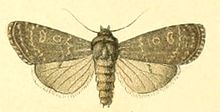Species of moth
This article has multiple issues. Please help
improve it or discuss these issues on the
talk page. (
Learn how and when to remove these template messages)
.mw-parser-output .hidden-begin{box-sizing:border-box;width:100%;padding:5px;border:none;font-size:95%}.mw-parser-output .hidden-title{font-weight:bold;line-height:1.6;text-align:left}.mw-parser-output .hidden-content{text-align:left}@media all and (max-width:500px){.mw-parser-output .hidden-begin{width:auto!important;clear:none!important;float:none!important))You can help expand this article with text translated from
the corresponding article in German. (November 2022) Click [show] for important translation instructions.
View a machine-translated version of the German article.
Machine translation, like
DeepL or
Google Translate, is a useful starting point for translations, but translators must revise errors as necessary and confirm that the translation is accurate, rather than simply copy-pasting machine-translated text into the English Wikipedia.
Consider
adding a topic to this template: there are already 1,808 articles in the
main category, and specifying|topic= will aid in categorization.
Do not translate text that appears unreliable or low-quality. If possible, verify the text with references provided in the foreign-language article.
You must provide
copyright attribution in the
edit summary accompanying your translation by providing an
interlanguage link to the source of your translation. A model attribution edit summary is Content in this edit is translated from the existing German Wikipedia article at [[:de:Euxoa birivia]]; see its history for attribution.
You may also add the template ((Translated|de|Euxoa birivia)) to the
talk page.
For more guidance, see
Wikipedia:Translation.
This article needs additional citations for
verification. Please help
improve this article by
adding citations to reliable sources. Unsourced material may be challenged and removed.Find sources:
"Euxoa birivia" –
news ·
newspapers ·
books ·
scholar ·
JSTOR (April 2021) (
Learn how and when to remove this message)
(
Learn how and when to remove this message)
Euxoa birivia is a moth of the family Noctuidae. It is found in Europe (France, Italy, Germany, Switzerland, Austria, Poland, Czech Republic, Slovakia, Hungary, Romania, Albania, Slovenia, Bosnia and Herzegovina, Bulgaria and Croatia), east to Ukraine, the Caucasus, Armenia, central Asia, Ili, Issyk-Kul, Turkey and Iran.
The wingspan is 34–41 mm. Warren states E. birivia Schiff. (= honoratina Donz., dolis Grote) (6c). Forewing dark ashgrey, with pale dusting;lines themselves ill-defined , but marked by paler scaling ; orbicular and reniform stigmata ochreous , or with the centres dark but ringed with ochreous; hindwing fuscous grey, paling towards base. Occurs in S. Europe, in the French and Swiss Alps, in Italy,, Austria and Hungary; — in the ab. taurica Stgr. the
pale scales are ochreous yellow, instead of white; this form occurs in Asia Minor and Turkestan.[1]
Adults are on wing from mid July to the end of August. There is one generation per year.
The larvae probably feed on the roots of various grass species.
- ^ Warren, W. in Seitz, A. Ed., 1914 Die Großschmetterlinge der Erde, Verlag Alfred Kernen, Stuttgart Band 3: Abt. 1, Die Großschmetterlinge des palaearktischen Faunengebietes, Die palaearktischen eulenartigen Nachtfalter, 1914
 This article incorporates text from this source, which is in the public domain.
This article incorporates text from this source, which is in the public domain.


 This article incorporates text from this source, which is in the public domain.
This article incorporates text from this source, which is in the public domain.